Underfloor Heating System CFD Simulation, ANSYS Fluent Training
$80.00 $40.00 Student Discount
In this project, the heat transfer of an underfloor heating system in an enclosed space is simulated and analyzed.
Click on Add To Cart and obtain the Geometry file, Mesh file, and a Comprehensive ANSYS Fluent Training Video.To Order Your Project or benefit from a CFD consultation, contact our experts via email (info@mr-cfd.com), online support tab, or WhatsApp at +44 7443 197273.
There are some Free Products to check our service quality.
If you want the training video in another language instead of English, ask it via info@mr-cfd.com after you buy the product.
Description
Introduction
Air conditioning is one of the most important branches of mechanical engineering. Regulating the temperature of a room or a building has always been one of the major concerns of air conditioning designers. The high cost of energy consumption required to provide conditioned air for each structure by its use has led to the design of the best air conditioning system for each structure. These designs require a lot of study and research, both in terms of construction and maintenance costs and in terms of best performance. Meanwhile, simulation and analysis of these systems can play an effective role in determining the most appropriate ventilation system for each structure.
Project description
In this project, the heat transfer of an underfloor heating system in an enclosed space was simulated and analyzed by ANSYS Fluent. it is assumed that the underfloor heating system generated heat flux is assigned to the bottom wall (other walls are considered to be adiabatic). Since in this analysis, an underfloor heating system is used to generate heat, no fluid flow inlet is used in this project and only a pressure outlet is defined. The heat transfer is of the free convection type and gravity acceleration must be considered. The energy and k-epsilon Realizable models are used to solve the energy equation, and fluid flow parameters and to thoroughly analyze the effects of buoyancy and volumetric forces resulting from density changes. It should be noted that the ideal gas model has been used to determine the density changes in proportion to temperature.
Geometry and mesh
The geometry required for this project consists of a room that is Designed in Ansys Design Modeler software and meshed by Ansys Meshing. The mesh type used for this geometry is unstructured and the element number is 124325.
Underfloor Heating System CFD Simulation
The key assumptions considered in this project are:
- Simulation is done using a pressure-based solver.
- The present simulation and its results are considered to be steady and do not change as a function of time.
- The effect of gravity has been taken into account and is equal to -9.81 m/s2 in the Z direction.
The applied settings are summarized in the following table.
| Models | ||
| Viscous model | k-epsilon | |
| k-epsilon model | realizable | |
| near wall treatment | standard wall function | |
| Energy | on | |
| (underfloor heating system) | Boundary conditions | |
| Outlet | Pressure outlet | |
| Gauge pressure | 0 Pa | |
| Turbulent intensity | 5 % | |
| Turbulent viscosity ratio | 10 | |
| Temperature | 300 K | |
| Walls | ||
| bottom wall | wall motion | stationary wall |
| Heat flux | 180 W/m2 | |
| Top and sidewalls | wall motion | stationary wall |
| Heat flux | 0 W/m2 | |
| (underfloor heating system) | Solution Methods | |
| Pressure-velocity coupling | coupled | |
| Spatial discretization | Pressure | second order |
| Density | second order upwind | |
| Momentum | second order upwind | |
| Energy | second order upwind | |
| turbulent kinetic energy | first order upwind | |
| turbulent dissipation rate | first order upwind | |
| (underfloor heating system) | Initialization | |
| Initialization method | Standard | |
| gauge pressure | 0 Pa | |
| Velocity (x,y,z) | (0,0,0) m/s | |
| temperature | 300 K | |
| Turbulent kinetic energy | 1 m2/s2 | |
| Turbulent dissipation rate | 1 m2/s3 | |
Underfloor Heating System Results
Contours of pressure, velocity, temperature, etc. are obtained and presented in both 3D and 2D.

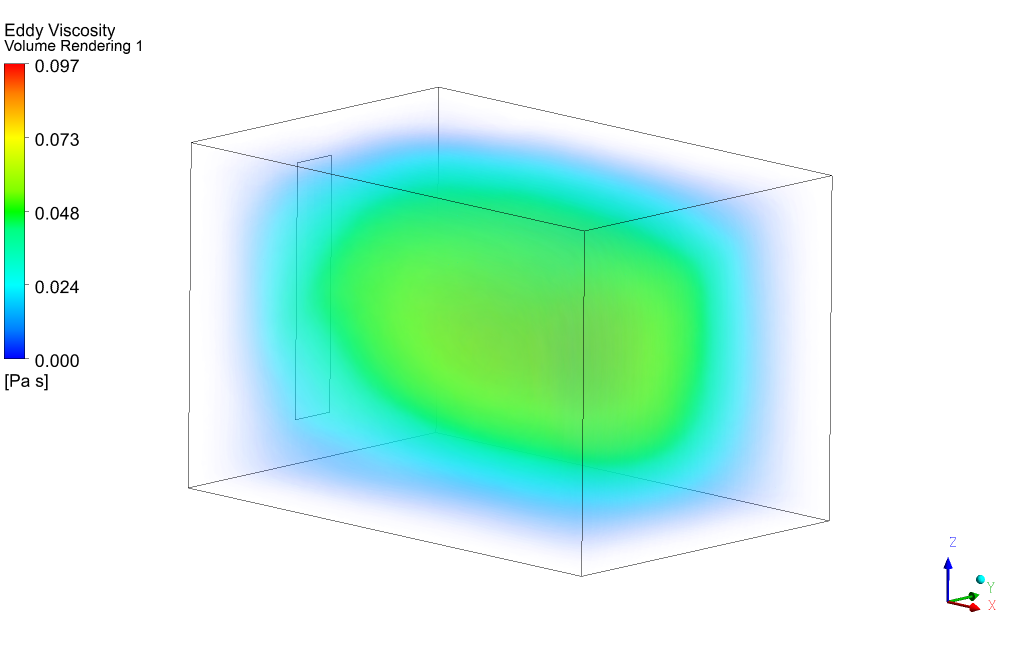
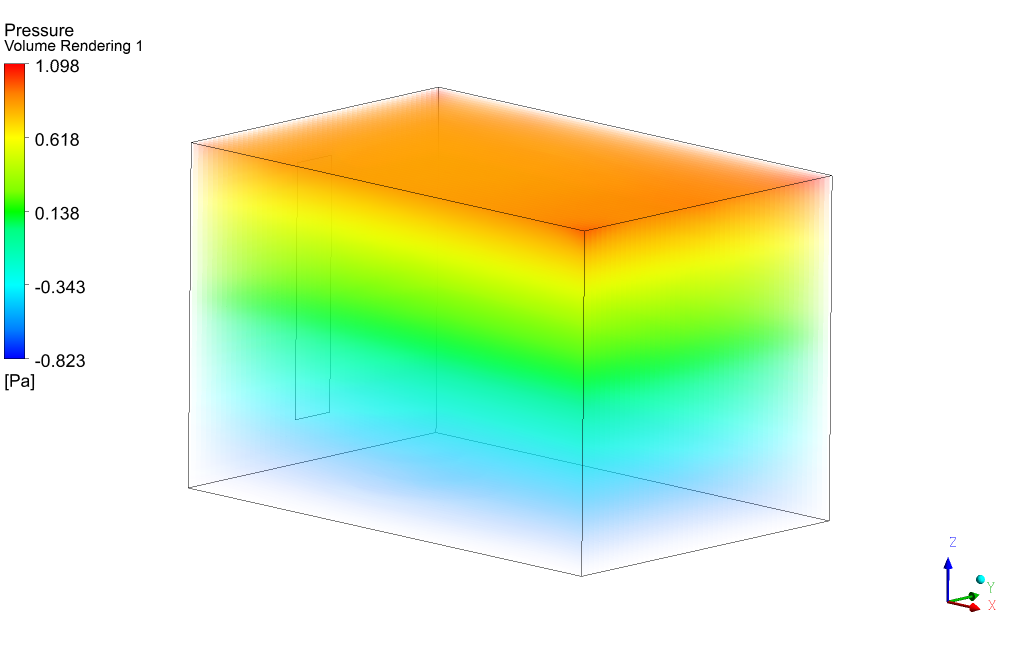
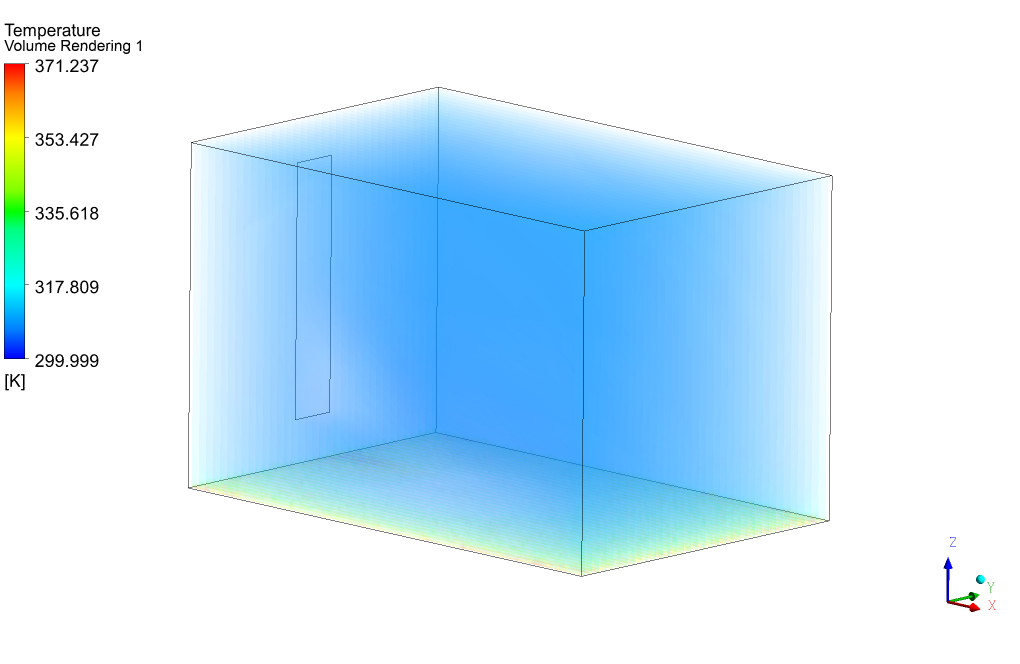
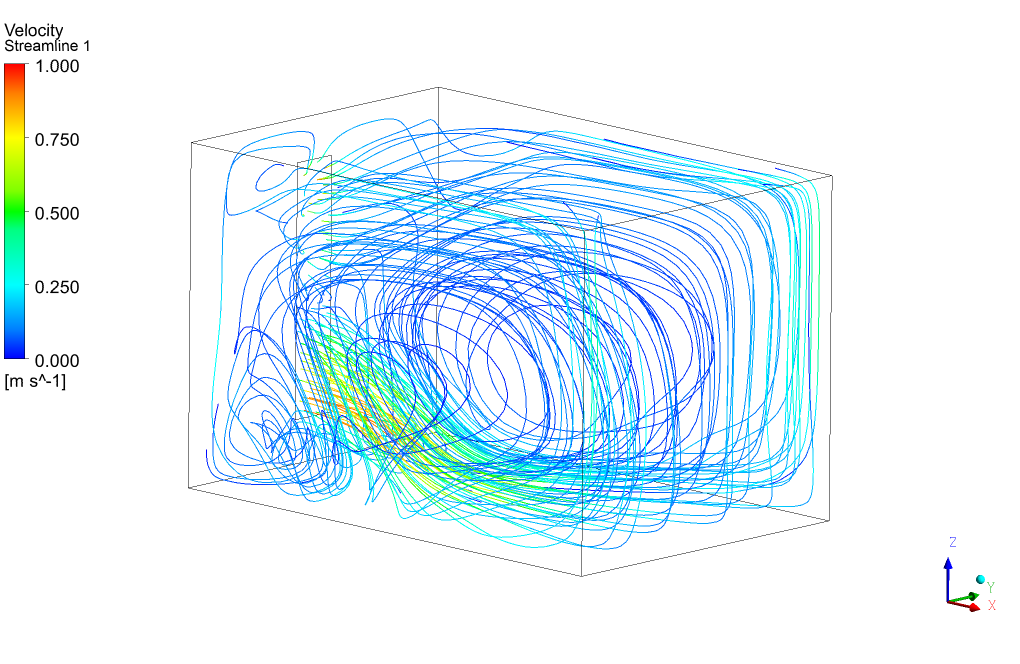
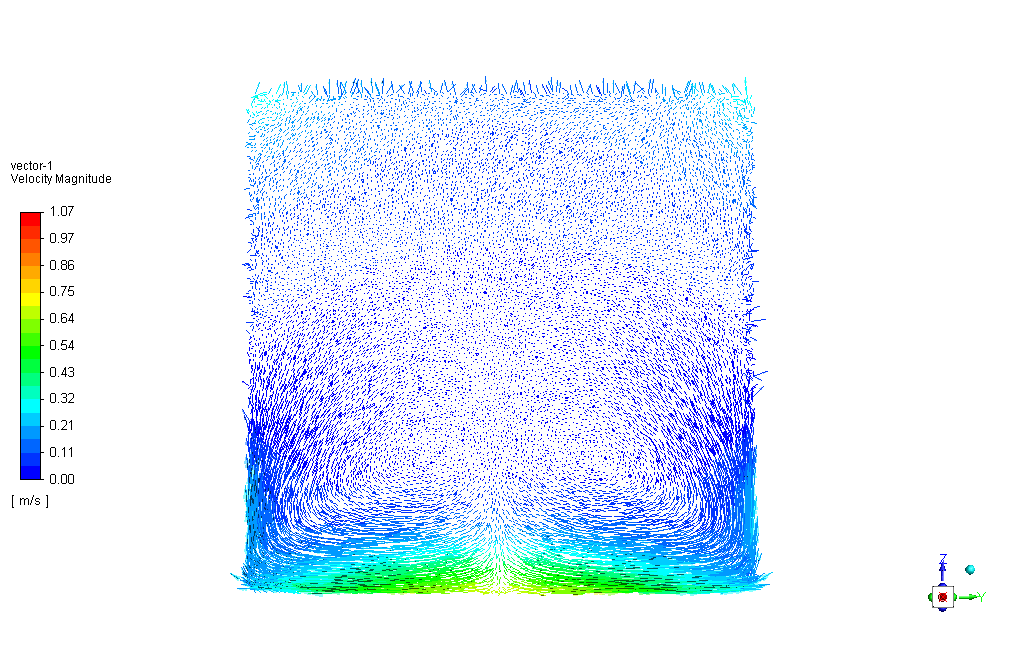
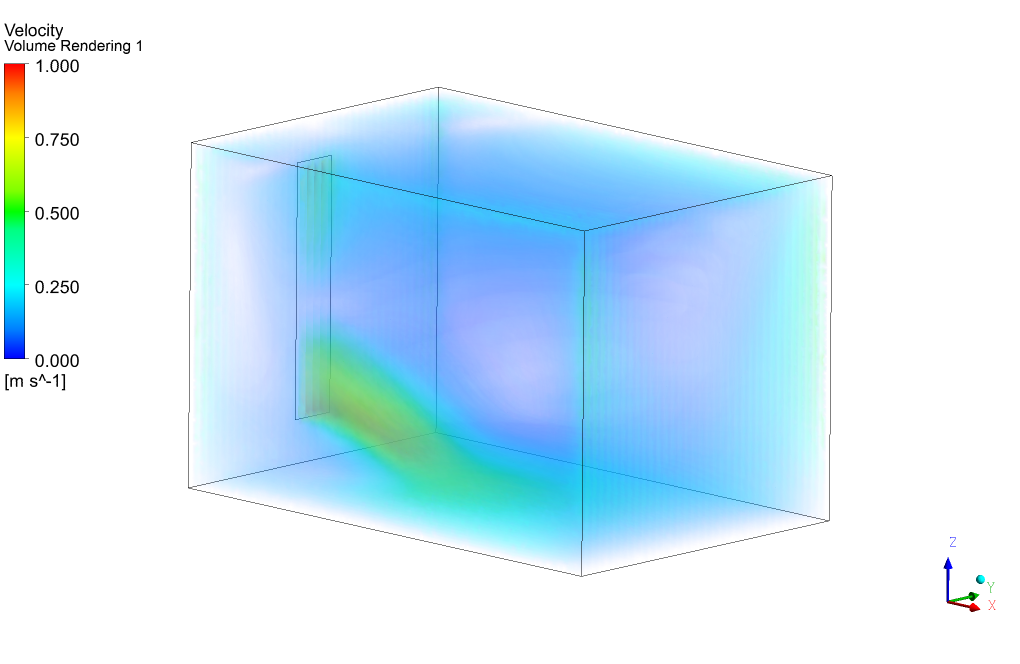


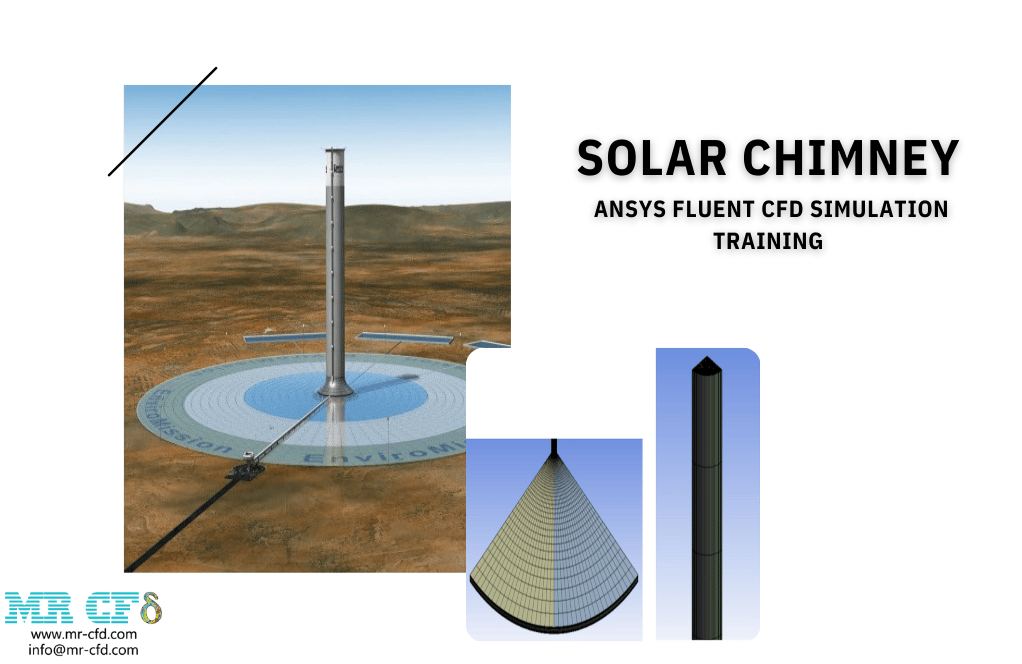

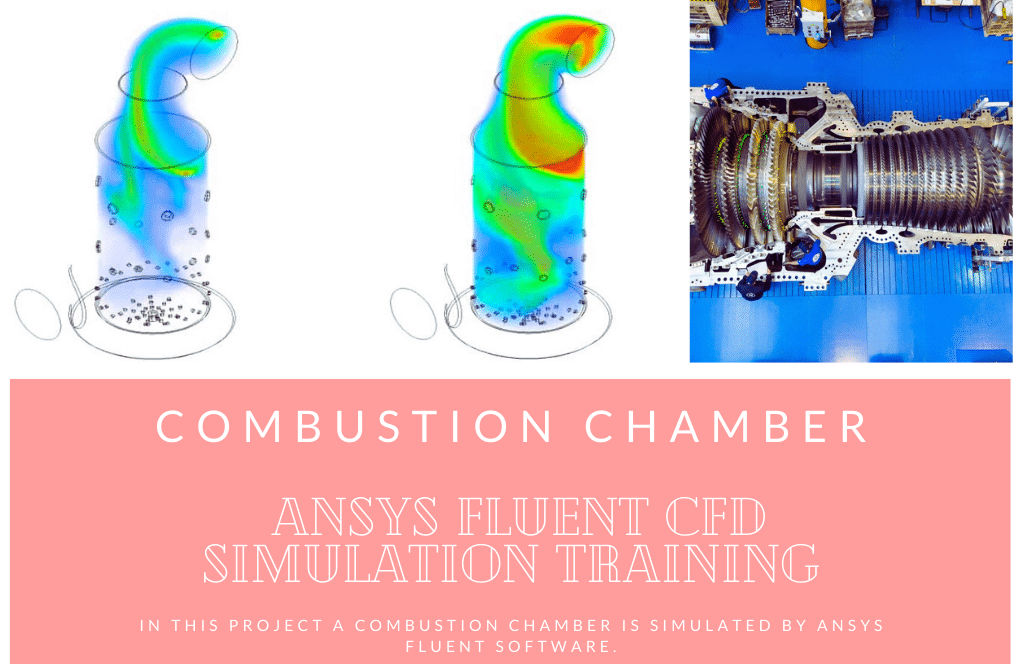

Mellie Windler –
This is an invaluable resource for anyone working in the field of heating system design and optimization.
Randy Wolff I –
Can I contribute to this simulation?
MR CFD Support –
We are open to contributions! Please share your ideas or suggestions.
Noemie Kirlin –
This simulation is a fantastic tool for understanding complex heat transfer phenomena in underfloor heating systems!
Ms. Kari Reichert –
I’m particularly interested in how the simulation accounts for buoyancy effects due to temperature variations. Could you expand on how density changes are modeled in this CFD simulation, especially under the influence of the underfloor heating system?
MR CFD Support –
In this CFD simulation, buoyancy effects due to temperature variations are accounted for through the use of the ideal gas model, which allows density changes to be calculated in relation to temperature. The k-epsilon realizable model, along with the energy equation, is utilized to thoroughly analyze the effects of buoyancy and volumetric forces that result from these density changes. Additionally, the simulation is configured to include the gravitational acceleration as -9.81 m/s² in the Z direction to ensure that natural convection is driven appropriately within the room.
Kariane Hettinger IV –
I am impressed by the level of detail in this simulation.
Mr. Francis Mueller –
I’m so impressed by how immersive the training from MR CFD is. Considering the pressure-based solver and the k-epsilon realizable model utilization, I’ve learned how essential fine-tuning various parameters is to the accuracy of a simulation—terrific work on illustrating the nuances of thermal dynamics in enclosed spaces. The option to see the outcomes in both 3D and 2D also solidified my understanding. This training broadened my knowledge impressively. Thank you for such an enlightening learning experience!
MR CFD Support –
Thank you for your kind words! We are thrilled to hear you had such a positive experience with our Underfloor Heating System CFD Simulation training. It’s wonderful that you found the training to be immersive and educational, and that you now have a deeper understanding of thermal dynamics and CFD analysis. If you have any further questions or require more advanced training, please do not hesitate to contact us. Your success and learning are what motivate us to provide such detailed simulations. Keep enjoying your journey in CFD exploration, and thank you for choosing MR CFD!
Mr. Jorge O’Hara –
I’m intrigued by the way the underfloor heating affects room temperature. Can the contour plots be used to predict temperature distribution for different room designs?
MR CFD Support –
Yes, the contour plots generated from the simulation can indeed be used to predict temperature distribution in different room designs. By comparing the temperature contours, one can assess how effectively the underfloor heating system distributes heat across the room. These insights enable designers to optimize the layout and materials for better thermal comfort and energy efficiency in various room configurations.
Mrs. Berenice Wunsch –
This CFD training sounds comprehensive. Did the course also cover strategies for optimizing the underfloor heating system efficiency through simulation?
MR CFD Support –
Thank you for the positive feedback on our training! While the primary aim of the CFD simulation is to illustrate the temperature distribution and heat flow within the heated space, strategies for optimizing the efficiency of the underfloor heating system would typically involve additional simulations to assess various scenarios. Suggestions for such optimizations might be offered as part of our advanced courses or additional training modules. If you are interested, I recommend exploring our range of courses or contacting us for more information on optimization strategies.
Kailee Ferry –
I enjoyed the comprehensiveness of the Underfloor Heating System CFD Simulation training. It walked me through all the necessary steps in setting up the simulation and the results were clear and easy to interpret. Great work on presenting both the 3D and 2D contours!
MR CFD Support –
Thank you for your review! We’re delighted to hear that you found the Underfloor Heating System CFD Simulation training comprehensive and clear. Your feedback is important to us, and we’re thrilled that our product met your expectations. If you ever have more questions or need further training, do not hesitate to reach out.
Bo Bahringer DDS –
I must say, the Underfloor Heating System CFD Simulation course was an eye-opener. The step-by-step training allowed me to understand the complexities of energy consumption and heat transfer within an enclosed space. The detailed explanations of setting up boundary conditions, addressing free convection, and including the effects of gravity in the simulation in ANSYS Fluent have significantly enhanced my comprehension of indoor air conditioning systems. A big shoutout to the MR CFD team!
MR CFD Support –
We’re thrilled to hear that our Underfloor Heating System course has provided you with valuable insights and a deeper understanding of energy and heat transfer simulations! At MR CFD, we strive to deliver comprehensive and detailed training, and your acknowledgment motivates us to keep offering high-quality education products. Thank you for your kind words and for choosing our course to enhance your skills!
Asha Volkman –
Thank you for the in-depth guide and training on the Underfloor Heating System simulation using ANSYS Fluent. The concept of utilizing both free convection and the k-epsilon model to achieve realistic results was quite enlightening.
MR CFD Support –
We appreciate your positive feedback on the Underfloor Heating System CFD Simulation training using ANSYS Fluent. We’re glad to hear that our detailed approach and the application of free convection and the k-epsilon model provided you with enlightening information. If you have any further questions or need more assistance, please don’t hesitate to reach out. Thank you for choosing our training material!
Valentina Zulauf –
The course content and presentation seem very detailed. I am considering enrolling and would like to know if the training includes support material, such as working files or any reference documents?
MR CFD Support –
The ANSYS Fluent training for the Underfloor Heating System does include comprehensive support materials to aid your learning experience. These materials often cover practical working files, detailed reference documents, and step-by-step guides that accompany the course modules.
Prof. Leanna Quitzon –
How are the results of the simulation visualized?
MR CFD Support –
The results are visualized using contour plots of temperature and velocity, providing a clear picture of the heat distribution and air flow in the room.
Dereck Fadel –
The training really illuminated the complexity of underfloor heating systems and their simulation. The free convection coupled with gravity made sense, and it’s awesome that everything from meshing to results was covered. Done any buildings in colder climates?
MR CFD Support –
Thank you for your positive feedback on our underfloor heating system training! We’re glad to hear that you found the complexity of the system well-presented and understandable. Regarding colder climate applications, our training material is structured in a way to provide fundamental understanding that can be applied to a broad range of scenarios, including buildings in colder regions. Please feel free to explore more of our simulations to find cases that specifically deal with extreme weather conditions.
Tommie Frami –
The training was superb! It provided me with a comprehensive understanding of setting up an underfloor heating system simulation using ANSYS Fluent. Everything from establishing the correct physical models to defining custom boundary conditions and interpreting the results was very clear. Now my simulations run smoothly and my design process has become much more efficient. Thank you, MR CFD Company!
MR CFD Support –
We’re thrilled to hear our training for the ‘Underfloor Heating System CFD Simulation’ was helpful to you! It’s fantastic to know the content was clear and has positively impacted your design process and simulations. We appreciate you choosing our learning products and taking the time to share your positive experience. If you have any further inquiries or need more training on any CFD topic, please don’t hesitate to reach out!
Vernice Swaniawski –
Can this underfloor heating simulation be used to optimize the system for larger spaces, or is it limited to the specific room size used in the project?
MR CFD Support –
The principles learned from this underfloor heating simulation can indeed be applied to larger spaces, but the specifics of the simulation settings like boundary conditions, mesh density, and other parameters would need to be adjusted for different room sizes to accurately predict performance for optimal energy efficiency and comfort levels.
Lessie Stoltenberg –
I’m impressed by the depth of the analysis in the underfloor heating system simulation. The comprehensive approach to modeling convection and considering buoyancy effects seems quite thorough. Can you share how this simulation might aid in real-world HVAC design for energy efficiency?
MR CFD Support –
We’re glad to hear that you appreciate the depth of our CFD simulation for underfloor heating systems. Simulations like these aid real-world HVAC design by providing detailed insights into temperature distribution and airflow patterns within a space. By understanding these factors, designers can optimize the placement of heating elements and insulation to maximize energy efficiency, ensuring that heat is distributed evenly and losses are minimized. The data generated can help to reduce the system’s operational costs and contribute to a more sustainable design approach.
Prof. Kyleigh Gorczany Jr. –
The information provided is wonderful. It’s really helpful to grasp how underfloor heating systems can be simulated and analyzed to assure optimal performance and efficiency. Great job explaining each step and the assumptions – makes it really accessible even for those of us who aren’t engineering experts!
MR CFD Support –
Thank you for your kind words! We are delighted to hear that our Underfloor Heating System CFD Simulation course could effectively convey the complex engineering concepts simply and make them accessible. Your feedback is greatly appreciated and motivates us to continue developing high-quality learning materials for our customers. If there’s anything else you’d like to know or any further assistance you need, please feel free to reach out!